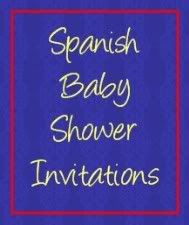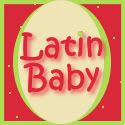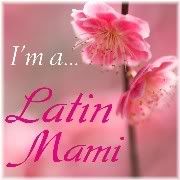It is good to know that all the discussion over the Latino drop-out rate and the paucity of Latinos going to college is beginning to result in some serious focus on Latino children and early education. A trumpet has been sounded and bilingual schools, while still fighting discrimination and misunderstanding, are starting to be recognized for their many benefits. Bilingual teachers are being recognized for their important role and some are even being treated as heroes. More and more companies are turning their attention to creating products and services for bilingual and Spanish-speaking families... and new ones are emerging with overwhelming success.
One of these is V-me, the largest and most widely distributed block of world-class educational pre-school content in Spanish TV from international leaders in quality, including Sesame Workshop, Thirteen/WNET, LazyTown Entertainment and Cromosoma.
This month, V-me began airing PEEP and the Big Wide World, on the Spanish-language network Monday through Friday from 9:15-9:30am. The Emmy Award-winning animated science series, bring its animated stories, science, and the wonders of everyday life for the first time to Spanish-speaking and bilingual preschoolers.
It is produced by WGBH and 9 Story Entertainment in association with TVOntario and Discovery Kids. Given WGBH Boston’s pioneering legacy in the production of children’s programming, this new partnership strengthens V-me’s commitment to education, information and quality entertainment for Latino families.
Young viewers join Peep, a newly-hatched chicken, Chirp, a smart and sassy robin, and an endearingly, egotistical duck named Quack on all their wide-eyed adventures—from discovering shadows, to investigating mysterious tracks, to learning about gravity. Underlying the series is a comprehensive science curriculum that uses humor, entertaining plotlines, and lovable characters to engage viewers in a way that allows them to learn about science without even realizing it. Each episode contains one animated PEEP story that highlights a specific science concept and one live-action video that presents real kids playing and experimenting with this same concept in their own “big wide worlds.”
“PEEP is a wonderful vehicle for fostering early science exploration and understanding, presenting science in a way that tickles the fancy and funny bones of our young preschool audience. We are thrilled that V-me—which represents the best educational preschool programming on Spanish TV—is adding PEEP to their children’s lineup and introducing the characters and real world science concepts of the series to Latino families,” says executive producer, Kate Taylor.
“On the educational landscape, there are tremendous gaps for Latinos and science, and research has demonstrated that PEEP effectively brings meaningful science experiences to preschoolers,” said Guillermo Sierra, Vice President of Programming at V-me. “By bringing Peep to V-me, we are able to expose our young viewers to science exploration early and foster an understanding that lasts them a lifetime.”
A Spanish section of the PEEP and the Big Wide World Web site is also being launched at http://www.peepandthebigwideworld.org/. Here, families can access numerous animated PEEP stories and their related live-action videos featuring real kids playing at home and outdoors. Additional online resources in Spanish provide Latino parents and caregivers with ideas for fun, educational hands-on activities that extend their child’s science learning beyond the show.
Our amigas over at Spanglish Baby are giving away SIX baskets full of PEEP Goodies. So head on over and throw in your comments for a chance to win!
Who knows, by introducing your child to science early, you may be molding the next José Moreno Hernández or Elsa Salazar Cade.
Wednesday, March 24, 2010
Friday, March 12, 2010
Literacy Developing Products for Babies and Toddlers
As we’ve mentioned, literacy begins at birth. Babies are full of wonder and are carefully exploring the world around them from the moment that they open their eyes. Shapes and sounds are being absorbed and categorized, filed away to help them begin speaking, learning, and - eventually - reading. Play is essential to a child’s development. Babies and children learn about concepts and relationships through play.
I’ve listed below some products that are very useful for Latino parents looking to develop their child’s love of learning and literacy. Not only do these products develop letter recognition, but they also develop fine motor skills. I’ve already mentioned a few of these on this blog, but it is nice to have them all in one post related to this topic. To purchase any of these products, simply click on the name of the product to be directed to the appropriate website.
Spanish ABC Puzzle Blocks
From Learning Resources. "Help children learn the Spanish alphabet (A through Z, plus ch, ll and n) with these two-piece wooden puzzles. Each kid-friendly puzzle features a fun picture of something beginning with a given letter and unique die cuts that match the shape of that letter. The wooden storage box with a plastic lid contains 29 two-piece solid wood puzzle blocks measuring 2" x 3.75" each. Box measures approximately 12" x 4.5"." To purchase your set, click here.
Easy Alphabet/¡Abecedario fácil!
This set is SO MUCH FUN! Packaged in a sturdy keepsake box with a magnetic closure, Easy Alphabet is made up of 27 cards plus a guide for parents. The guide is in both English and Spanish and describes different ways in which to use the cards with your child. An excellent product for developing your child’s early literacy skills, this set is geared for children ages 1 year and older. Even better, it grows with your child as you’ll see by the different activities listed in the parent’s guide. Like the board books described above, these cards are nice and thick with rounded corners. As an additional bonus, parents can visit BilingualReaders.com to find free audio files and extra activities to supplement these products.
Entertaining, educational book introduces Spanish-speaking preschoolers and English-speaking youngsters to the 28 letters of the Spanish alphabet and almost 225 everyday Spanish words. Each letter is accompanied by illustrations of common objects whose names begin with that letter. A low-priced, entertaining and effective introduction to Spanish language skills.
29 Spanish Alphabet Mini-books
Easy-to-make reproducible books that promote literacy build letter and sound recognition. Just reproduce, fold, and snip! Students practice handwriting, begin letter collections, and make personalized Spanish word banks.
Spanish Alphabet Big Book
PreK and up. Reinforce letter recognition, spelling, sounds, and beginning words with this unique pocket chart that uses color coded letters and pictures. Easy-to-clean nylon chart features three clear pocket rows for card displays. Measures 28 1/4"W x 37 3/4"H.
I’ve listed below some products that are very useful for Latino parents looking to develop their child’s love of learning and literacy. Not only do these products develop letter recognition, but they also develop fine motor skills. I’ve already mentioned a few of these on this blog, but it is nice to have them all in one post related to this topic. To purchase any of these products, simply click on the name of the product to be directed to the appropriate website.
A Spanish language set comprised of 28 blocks that provide 4 complete alphabets, 3 sets of numerals, and 28 different animal pictures. The set includes the Spanish letters "CH", "Ñ", and "LL". Made from Michigan basswood, brightly colored with child-safe inks, and handcrafted with attention to detail. The blocks are a generous1 ¾” (44mm) cubed a perfect size for small hands!
Spanish ABC Puzzle Blocks
From Learning Resources. "Help children learn the Spanish alphabet (A through Z, plus ch, ll and n) with these two-piece wooden puzzles. Each kid-friendly puzzle features a fun picture of something beginning with a given letter and unique die cuts that match the shape of that letter. The wooden storage box with a plastic lid contains 29 two-piece solid wood puzzle blocks measuring 2" x 3.75" each. Box measures approximately 12" x 4.5"." To purchase your set, click here.
Easy Alphabet/¡Abecedario fácil!
This set is SO MUCH FUN! Packaged in a sturdy keepsake box with a magnetic closure, Easy Alphabet is made up of 27 cards plus a guide for parents. The guide is in both English and Spanish and describes different ways in which to use the cards with your child. An excellent product for developing your child’s early literacy skills, this set is geared for children ages 1 year and older. Even better, it grows with your child as you’ll see by the different activities listed in the parent’s guide. Like the board books described above, these cards are nice and thick with rounded corners. As an additional bonus, parents can visit BilingualReaders.com to find free audio files and extra activities to supplement these products.
Entertaining, educational book introduces Spanish-speaking preschoolers and English-speaking youngsters to the 28 letters of the Spanish alphabet and almost 225 everyday Spanish words. Each letter is accompanied by illustrations of common objects whose names begin with that letter. A low-priced, entertaining and effective introduction to Spanish language skills.
29 Spanish Alphabet Mini-books
Easy-to-make reproducible books that promote literacy build letter and sound recognition. Just reproduce, fold, and snip! Students practice handwriting, begin letter collections, and make personalized Spanish word banks.
Spanish Alphabet Big Book
PreK and up. Reinforce letter recognition, spelling, sounds, and beginning words with this unique pocket chart that uses color coded letters and pictures. Easy-to-clean nylon chart features three clear pocket rows for card displays. Measures 28 1/4"W x 37 3/4"H.
Monday, March 1, 2010
Literature on Latino Education Practices
Latino parents and educators may find the following books to be great resources for learning how to get involved in their children's education. Click on the title to read more reviews or to purchase your copy.
Involving Latino Families in Schools: Raising Student Achievement Through Home-School Partnerships by Concha Delgado Gaitan to be a wonderful resource. The book has received excellent reviews and is highly recommended. This updated edition of Setting Our Sights outlines the five stages for equity reform, while clearly explaining research findings and offering practical tools and examples.
Building Culturally Responsive Classrooms: A Guide for K-6 Teachers by Concha Delgado Gaitan. The author shows how teachers honoring real culture can transform the context and content within their classrooms while creating learning settings that challenge students academically.
 Quality Education for Latinos and Latinas: Print and Oral Skills for All Students, K-College by Rita Portales and Marco Portales. As educators and legislators across the country debate how to improve public schools, the most vital factor often disappears from the equation--the relationship between the teacher and the student. According to veteran educators Rita and Marco Portales, this relationship is the central issue in the education of students, especially Latino/a students who often face serious barriers to school success because of the legacy of racism, insufficient English-language skills, and cultural differences with the educational establishment. To break down these barriers and help Latino/a students acquire a quality education, the Portaleses focus attention on the teacher-student relationship and offer a proven method that teachers can use to strengthen the print and oral skills of their students. They begin by analyzing the reasons why schools too often fail to educate Latino/a students, using eloquent comments from young Latinos/as and their parents to confirm how important the teacher-student relationship is to the student's success. Then they show how all educational stakeholders--teachers, administrators, state education agencies, legislators, and parents--can work together to facilitate the teacher-student relationship and improve student education. By demonstrating how teachers can improve students' reading, critical thinking, writing, and oral communication skills across the curriculum, they argue that learning can be made more relevant for students, keeping their interest levels high while preparing them for academically competitive colleges.
Quality Education for Latinos and Latinas: Print and Oral Skills for All Students, K-College by Rita Portales and Marco Portales. As educators and legislators across the country debate how to improve public schools, the most vital factor often disappears from the equation--the relationship between the teacher and the student. According to veteran educators Rita and Marco Portales, this relationship is the central issue in the education of students, especially Latino/a students who often face serious barriers to school success because of the legacy of racism, insufficient English-language skills, and cultural differences with the educational establishment. To break down these barriers and help Latino/a students acquire a quality education, the Portaleses focus attention on the teacher-student relationship and offer a proven method that teachers can use to strengthen the print and oral skills of their students. They begin by analyzing the reasons why schools too often fail to educate Latino/a students, using eloquent comments from young Latinos/as and their parents to confirm how important the teacher-student relationship is to the student's success. Then they show how all educational stakeholders--teachers, administrators, state education agencies, legislators, and parents--can work together to facilitate the teacher-student relationship and improve student education. By demonstrating how teachers can improve students' reading, critical thinking, writing, and oral communication skills across the curriculum, they argue that learning can be made more relevant for students, keeping their interest levels high while preparing them for academically competitive colleges.
Subscribe to:
Posts (Atom)

















